There are certainly many stunning and practical Syzygium species throughout Australia but not many can provide the bushfood qualities and ornamental influence in landscapes much like the Aniseed Myrtle tree can.
This spectacular rare native rainforest tree sports glossy green leaves alongside fluffy creamy-white flowers borne in panicles in summer, both of which are highly fragrant.
A well-known bush tucker, this plant is now widely cultivated in plantations for its edible leaves and essential oils. Here is your ultimate gardening guide to growing and caring for this special Syzygium species.
More...
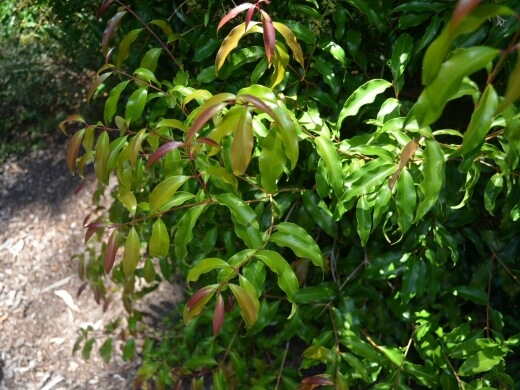
Source: gardeningwithangus.com.au
Family: | Myrtaceae |
|---|---|
Genus: | Syzygium |
Species: | S. anisatum |
Common Names: | Aniseed myrtle, Aniseed tree, Anise myrtle, Ringwood tree |
Location: | Outdoor |
Type: | Small to large tree |
Growth: | 4 to 10 metres tall, 3 to 6 metres wide |
Sun requirements: | Full sun, light shade, half shade |
Foliage Colour: | Green |
Flower Colour: | Creamy white |
Flowering: | Spring to summer |
Maintenance level: | Low |
Poisonous for pets: | Toxic to cats and dogs if ingested |
The lush-green wavy leaves and fluffy cream flowers both share a sweetly aromatic scent, further boosting their impact within gardens. The tree itself forms an attractive dense crown and it can be grown as a smaller shrub or a large tree, giving growers plenty to work with in their spaces.
The leaves can be used at home as a flavourful spice in many culinary dishes and they can also be used as a herbal tea ingredient with many nutritional benefits.
Enjoy year-round ornamental dense and glossy foliage supported by prolific white fragrant blooms throughout summer.
Getting to Know the Aniseed Myrtle
Botanically named Syzygium anisatum, common names now include aniseed myrtle, aniseed tree, anise myrtle and ringwood. This rainforest tree is native to parts of Nambucca and Bellinger Valleys in the sub-tropics of northern New South Wales, forming a part of the widespread Myrtaceae family.
It thrives in sub-tropical, warm temperate and Mediterranean climates, making it a perfect fit for most Australian gardens. It is related to Lemon Myrtle and shares many similar essential oil profiles in its leaves with true aniseed.
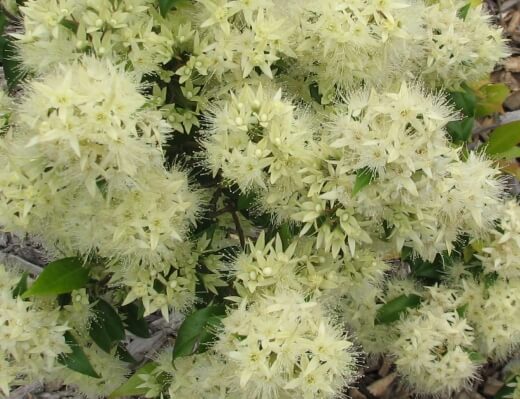
Source: en.wikipedia.org
Natural Habitat of Syzygium anisatum
In its natural habit, this tree can grow up to 45 metres tall but in cultivation within gardens, it will grow to around 4 to 10 metres tall and 3 to 6 metres wide, depending on how it is pruned.
The growth habit is evergreen with dense foliage and a spreading form. This gorgeous perennial will also attract local birdlife, bees and butterflies so it’s also a great pick for native flowering gardens aiming to be more fauna-friendly.
Thanks to the lush, relaxed and arching foliage along with the tree’s naturally attractive form, it can be used in many applications within gardens, big or small.
The leaves start in soft-pink clusters that mature to a glossy green, further elevating the spectacle this plant is capable of.


Get Your Free Guide:
Master Growing Australian Natives eBook
A Must Have Complete Guide for Every Australian Garden
Get Your Free Guide:
Master Growing Australian Natives eBook
A Must Have Complete Guide for Every Australian Garden
It can make for a great low-maintenance garden feature, can be grown in large containers, makes for a perfect gap filler or can be potted as an edible ornamental.
Either way, there’s a lot to love about this native tree. It is important to note that it is toxic to pets if ingested so placement will need to be considered accordingly.
How to Grow Aniseed Myrtle
This tree can be grown from seed or propagated using cuttings. Healthy seeds or young nursery plants can be found at reputable retailers in-store and online.
But if you have access to a healthy parent plant, cuttings do tend to ensure a consistent quality of essential oil and nutritional leaves. It is important to note that the seeds do have low germination rates and the plant will take far longer to reach maturity than a nursery plant or cutting.
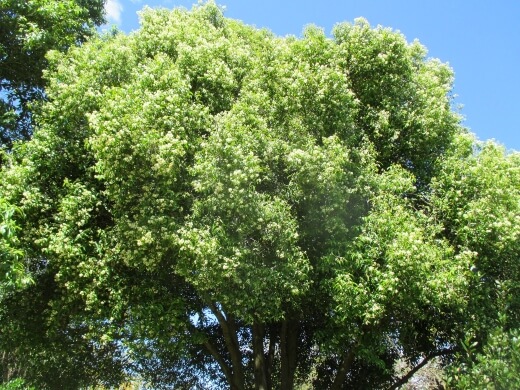
Source: plantarium.ru
Propagating Syzygium anisatum
Growing Ringwood Tree from Seed
- Soak seeds overnight and prepare well-draining seed trays filled with a quality seed-raising mix.
- Sow the seeds lightly into the soil then cover with a delicate layer of mix.
- Lightly mist or water after sowing.
- Place the seeds in a warm and sunny location with shelter from cold drafts.
- Mist regularly to keep the soil mixture moist.
- Germination can occur within about 4 to 8 weeks depending on the conditions.
- Allow sprouted seedlings to develop for at least another year before transplanting into larger containers for further development.
Propagating Aniseed Tree from Cuttings
- You can use softwood cuttings, semi-hardwood cuttings or hardwood cuttings for your propagation.
- Using a sharp and sterilised pair of secateurs or scissors, cut a few healthy stems off the main plant. (See our review of the best pruning shears for reference.)
- Each stem cutting should still have several leaf nodes for the best results.
- Strip the foliage off the bottom 3 centimetres of the cuttings.
- Prepare small well-draining containers with a mixture of coarse sand and a quality potting mix.
- Place the cut ends of the stems into the pots and water well after planting.
- Place the cuttings in a warm and sunny location, being sure to keep the mixture moist but never soggy at all times.
- Allow cuttings to develop for about 12 months before transplanting them into the garden.
Best Conditions for Planting Anise Myrtle
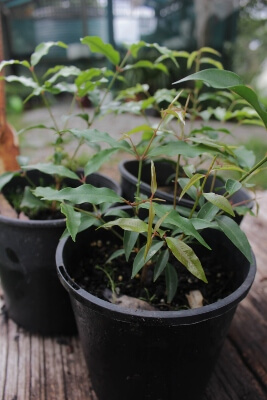
Source: peppermintridgefarm.com.au
Being a well-adjusted native, this plant can tolerate a wide range of growing conditions but naturally does prefer and grow best given certain conditions. Long exposure to frost should be avoided, especially for younger specimens.
Soil Needs
The tree will grow well in clay, loam, sandy loam or potting mixes as long as good drainage is provided. For more clay-heavy soils, you can add some organic compost and a little perlite to increase the breathability within the soil to ensure it drains well.
Soil pH can be neutral to slightly acidic. The soil must also be able to retain a moderate amount of moisture at all times. Before planting, be sure to enrich your soil with organic compost. To test your soil, try out this soil testing kit.
Sunlight Preference
Though the tree can be successfully established in full sun to half shade, it does prefer and perform best with some afternoon shade. A good goal is to let your tree get about 6 hours of full sun each day with dappled afternoon light.
How to Care for Aniseed Tree
Once established, your tree should be tolerant to light frost and drought. Young plants will need to be sheltered from frost and periods of drought should be avoided until fully established.
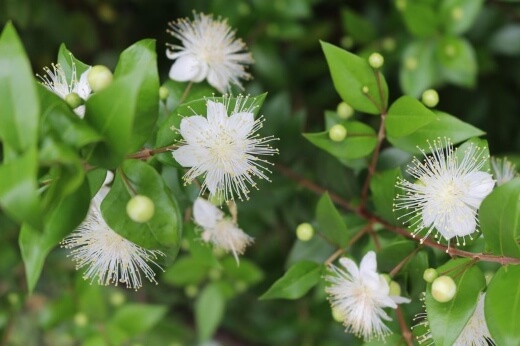
Source: ahimsaoils.com.au
Pruning Requirements
Established trees will look fantastic if tip-pruned regularly. Pruning is especially important in the first few years to encourage growth, the density and to develop your desired shape as your tree grows.
This plant responds very well to pruning so even large trees can be pruned to size. Growth can also be cut to maintain a shrub or small tree form in your landscape. Prune in late winter before the active growing seasons.
Watering the Aniseed Tree
These trees require a consistent water supply along with good drainage. Water as needed to keep the soil moist. Water more in very hot, dry summers and less in winter.
Fertilising & Mulching
Mulch annually in summer around the plant with an organic blend. Feed your tree twice a year with a general-purpose slow-release fertiliser or similar native fertiliser.
Aniseed Myrtle Bush Tucker Guide
The aromatic leaves of this tree can be used in many different ways. For herbal teas, you can steep the leaves in water fresh or dry. However, for most recipes, the leaves will need to be dried and ground up to be used as more of a herb-like ingredient.
The flavour profiles of the leaves include sweet liquorice and aniseed flavours respectively, coming from the essential oils contained within them.
Nutrition contents and benefits of consuming the leaves include:
- They sport a superior antioxidant profile.
- They are high in vitamin C, E. folate, lutein, zinc, calcium, magnesium and chlorophyll A and B. This will ensure you are receiving a well-balanced combination of essential vitamins, minerals and micronutrients when using these leaves.
- Traditionally, the leaves were used as a medicinal tonic for general health, weight loss, lactation and stomach issues.
- The leaves are also famed for their antimicrobial properties.
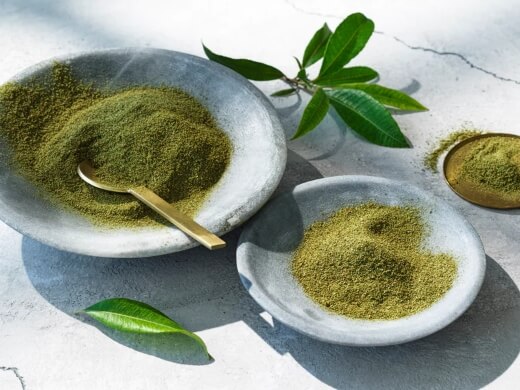
Source: australiannativeproducts.com.au
How to Harvest & Prepare Aniseed Myrtle Leaves
- Harvest by simply plucking leaves straight off the tree.
- Pick leaves that don’t crack and break easily.
- Rinse leaves after harvesting to remove dirt and debris.
- To dry leaves, leave them in a warm and dry location until ready. Alternatively, you can speed up the drying by using a food dehydrator or even your oven on a low setting.
- Once dried, you can ground the leaves using a coffee grinder or manually grind them into a fine powder.
- Thanks to the fact the leaves grow back very fast, you’ll have a fresh harvest throughout the year.
Cooking with Aniseed Myrtle
Once in powder form, the leaves can be added to many sweet and savoury dishes, easily enhancing your culinary experience in the kitchen. They can be used to flavour biscuits, pasta, bread, cakes or even ice-creams. It makes for an excellent replacement for star anise as well.
Furthermore, you can add ground leaf powder to syrups, glazes for meaty dishes or even dressings for salads. There are many tasty and nutritious recipes available online so be sure to find a few that might interest you and your family.
Here are a few recipes worth checking out to help you get started:
Ringwood Tree Pests & Diseases
In gardens, these trees rarely suffer from any pest and disease issues. However, as with many of the other members in the family, this plant can be susceptible to myrtle rust on rare occasions.
This fungal disease can severely threaten new growth and the entire production system of the tree. It is a more recent disease that has become a problem for many native food species, especially anise myrtle.
Left untreated, the disease can spread and cause disfigured foliage, heavy leaf-drop and even dieback. Heavily affected plants must be removed and disposed of to protect the surrounding vegetation and other myrtles.
Treatment is unfortunately still very limited and there is currently no cure for this fungal disease.
Aniseed Myrtle Frequently Asked Questions
Is aniseed myrtle a herb?
They are considered a very popular and tasty Australian bush herb. Many uses of the leaves in dishes are also very similar to that of normal household herbs.
What does aniseed myrtle smell like?
Like their taste, the leaves also feature pleasant sweet aromas of liquorice and aniseed. Even the flowers of this rainforest truly smell fantastic.
What is anise myrtle essential oil good for?
It can be used to treat anxiety, depression and even insomnia. It is a very calming, soothing and uplifting ingredient. It can also be used as a digestive and respiratory oil.
Interested in also growing the closely related and equally gorgeous lemon myrtle tree? Be sure to refer to our helpful and informative guide below for more information:
Other popular Syzygium worth looking at:
Enhance the Aroma & Spectacle of your Garden with the Aniseed Myrtle
Boasting highly ornamental and profuse foliage and flowers, this special rainforest tree is the perfect addition for anyone looking to establish a decorative native tree or anyone interested in capitalising on the year-long nutritious leaf yields.
Offering growers with so many useful and attractive applications within their landscapes, this tree is certainly an all-around stunner. Enjoy a relaxed arching form, tasty and fragrant evergreen leaves and prolific sweetly-scented creamy blooms with the aniseed myrtle tree.
Published on August 4, 2022 by Lorri Hopkins
Last Updated on January 18, 2025




